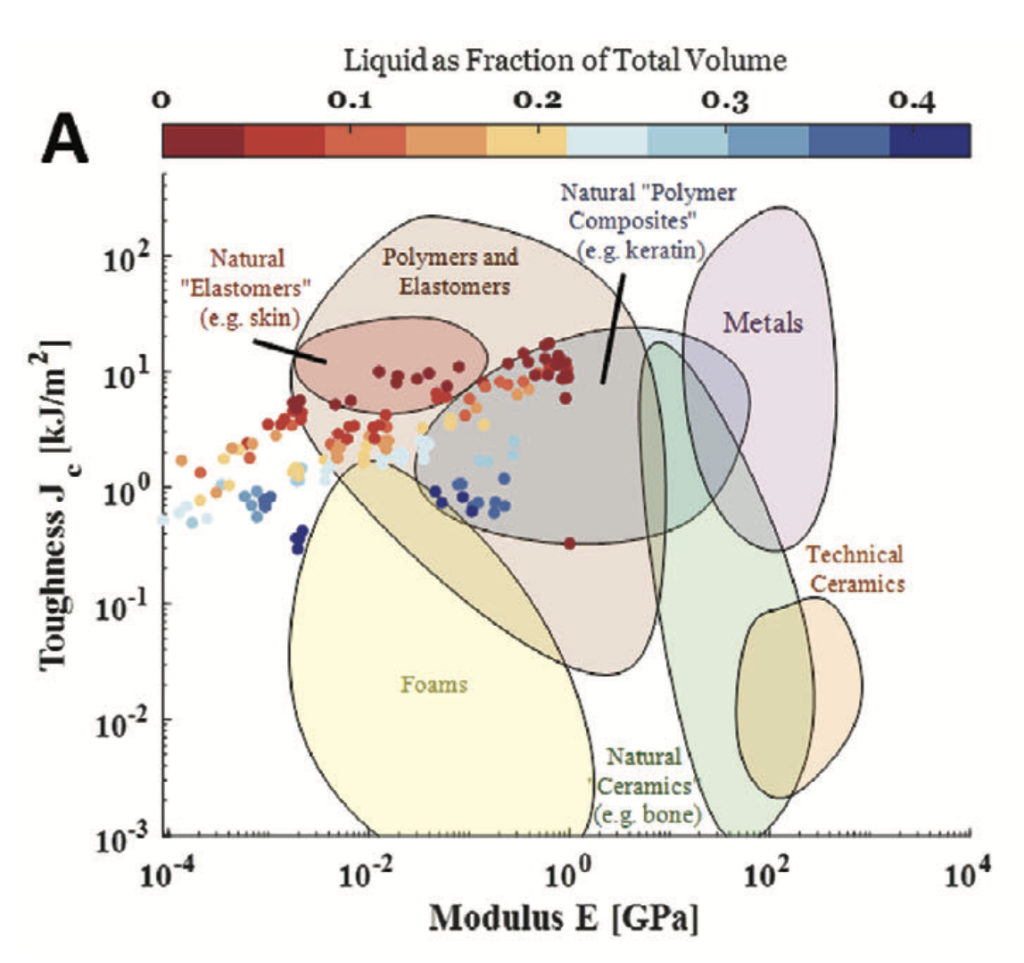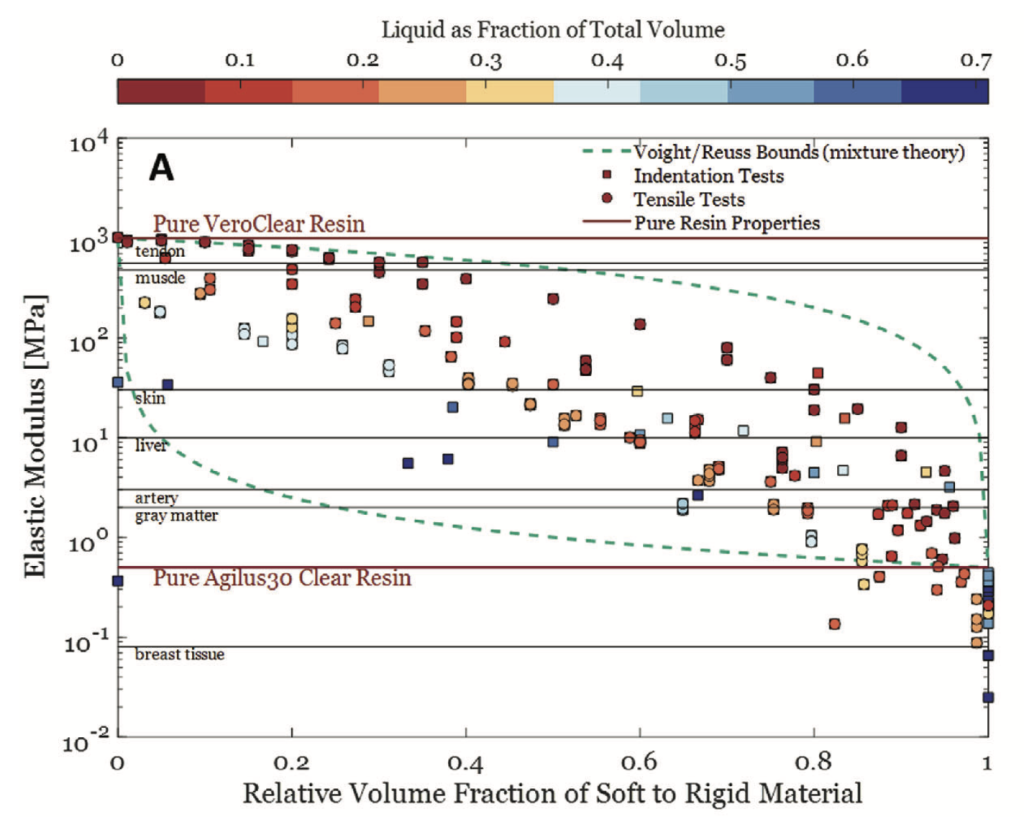Researchers from the University of Colorado Boulder have developed a novel process for determining material properties in inkjet additive manufacturing.
Called a “pantone for properties” by study co-authors Robert MacCurdy and Lawrence Smith, these findings outline how multi-material inkjet 3D printing can create specific material properties by combining different resin materials.
Similar to how a specific color can be created by mixing different primary colors, these findings outline how repeatable 3D printed material properties can be realized by mixing three “primary” materials. These materials include a soft elastomer, a rigid plastic, and liquid constituents.
In the study, the researchers used custom software to design hundreds of digital composite material samples. Once 3D printed, the mechanical properties of the samples were tested and characterized. Analytical mappings comparing composite ingredients and mechanical properties were then created, enabling “inverse material design.”
This process reverses the traditional material selection processes. Typically, engineers search for a suitable material which possesses desired material properties, and then create a design based on the material. Instead, the new methodology enables a desired set of material properties to be specified first for a part, which is then 3D printed.
The authors claim this research is the first to characterize digital material composites made from three inkjet materials with different mechanical properties. Previous studies have only assessed two-material composites, which “fall short of mechanical realism.”
Potential applications for this process are diverse. The researchers highlight 3D printing mechanically-plausible synthetic biological tissue as being one potential use-case. Leveraging the inverse material design approach, users can design and 3D print materials with any combination of stiffness and toughness needed to accurately mimic biological tissue.
The study, titled “Digital Multiphase Composites via Additive Manufacturing,” has been published in Advanced Materials.

A pantone for 3D printed material properties
Multi-material inkjet 3D printers jet droplets of photopolymer resins that are then cured by a UV light source, forming 3D objects.
The Agilus and Vero inkjet 3D printing resins from 3D printer manufacturer Stratasys possess different properties after curing. Agilus becomes a tough and flexible elastomer material, while Vero forms a rigid plastic. These two materials can be combined in different ratios to create composite materials with different properties. However, the property possibilities of these combinations are limited.
To achieve greater material-property freedom, the University of Colorado researchers added a third, liquid-based material into the composite design process. During the research, 188 tests were conducted on 110 unique composite material formulations.
Through experimental observation and validation using 3D printed parts, the researchers showed that it is possible to independently dictate mechanical properties like elasticity and toughness by combining the 3 base-materials.
Mechanical testing was carried out using a punch test. 3D printed test samples were exposed to a stainless steel dowel lowered through the “punch region.” The team then recorded the indentation distance and force of the samples, with the test terminating when the material failed.

The results of this testing highlighted that elastic modulus and toughness properties are decoupled, and can be independently specified during 3D printing. What’s more, the study concluded that any two material properties can be decoupled using this approach. This is enabled by the addition of the third liquid-based material into the composite design process.
The researchers also demonstrated inverse design of 3D printed objects with prescribed properties. This was achieved by creating mappings between compound material ingredients at the microscale, and macroscale material properties.
Using analytical modeling and mathematical equations, the researchers successfully used these mappings to accurately estimate the mechanical properties of a variety of inkjet composites that combine elastomer, rigid, and liquid resins.
Ultimately, the researchers argue that these findings hold significant potential within medical applications.
With current methods, researchers have struggled to achieve accurate material properties that reflect biological tissues. The findings of this study are said to enable the stiffness and toughness of a material to be simultaneously and independently altered. This allows researchers, designers, and medical practitioners to 3D print realistic and mechanically convincing synthetic biological tissue.

Research into inkjet 3D printing
MacCurdy and Lawrence’s research is not the first to explore the potential offered by multi-material inkjet 3D printing for medical applications. Researchers from the MIT Media Lab, Harvard University’s Wyss Institute, and the Dana-Farber Cancer Institute developed a method to 3D print hybrid living materials.
Called the Hybrid Living Material (HLM) fabrication platform, the team used multi-material inkjet 3D printing and customized material recipes to combine resins and chemical signals. These signals activate responses in biologically engineered microbes, offering potential for medical devices with therapeutic agents.
In this research, a suitable support resin was combined with a structural resin material to 3D print parts that become absorbent and retain chemical signals to control the behavior of living organisms. The HLM platform can leverage three to seven different resins with different properties, mixed in a range of proportions with synthetic biological material.
Elsewhere, a team from Martin Luther University Halle-Wittenberg developed a hybrid additive manufacturing process that combines extrusion and inkjet 3D printing.
This approach enables liquid inks to be integrated directly into solid material matrices. One key application of this is the integration of active medical ingredients into 3D printed drug delivery devices at the initial manufacturing stage.
The team also identified applications in structural engineering. Here, fluorescent liquids can be housed in solid structural components, allowing users to visual monitor cracks.
Subscribe to the 3D Printing Industry newsletter to keep up to date with the latest 3D printing news. You can also follow us on Twitter, like our Facebook page, and subscribe to the 3D Printing Industry Youtube channel to access more exclusive content.
Are you interested in working in the additive manufacturing industry? Visit 3D Printing Jobs to view a selection of available roles and kickstart your career.
Featured image shows the experimental results, with color indicating the volume fraction fluid.


